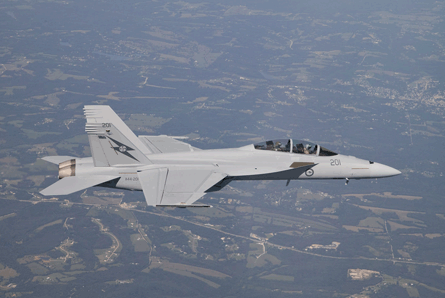Boeing yesterday revealed a number of surprising development efforts in the strike fighter market, including an external weapons bay for the F/A-18E/F and the existence of an in-production product stamped "proprietary".
The briefing appeared staged to showcase Boeing's long-term commitment in the manned fighter market despite losing the Joint Strike Fighter contract nearly nine years ago to Lockheed Martin.
Boeing now anticipates that production of F-15s and F/A-18E/F will continue through the mid-2020s, although both lines are scheduled for shutdown in 2012 and 2015 in the absence of new orders.
 |
|---|
© Boeing |
After unveiling a package of radar cross-section improvements for the F-15 last year named Silent Eagle, Boeing displayed a package of new enhancements offered as options on new sales of the Super Hornet.
The most visible change is an externally mounted pod mounted on the Super Hornet's centreline hardpoint. The pod is able to carry either a mix of two Mk82-class bombs and two AIM-120 missiles, or four AIM-120 missiles.
The external pod would help to reduce the Super Hornet's radar cross-section by removing missiles and bombs from external hard points.
Unlike the Silent Eagle, which was focused on reducing the F-15E's radar cross-section and updating the electronic warfare system and avionics, the new Super Hornet features are intended to provide a broader spectrum of improvements, says Shelley Lavender, Boeing vice-president and general manager of global strike systems.
Boeing also plans to offer other upgrades for the Super Hornet, including conformal fuel tanks and an infrared search and tracking system.
Beyond the F-15 and F-18 product lines, Boeing sees a bright future in the strike fighter market. As the supplier for the Lockheed F-22's operational flight programme, Boeing is deeply involved in the US Air Force's upgrades roadmap for that aircraft. Meanwhile, the US Navy is asking contractors to bid for a carrier-based unmanned aircraft system that could be deployed in 2018.
 |
|---|
© Boeing |
Both the USN and US Air Force are also starting the process of defining their needs for a next generation air dominance fighter that would begin after 2025 to replace the Super Hornet and F-22.
Boeing's Lavender also showed a chart to reporters that included a new product that enters production this year, but was marked only "proprietary". Asked to elaborate and clarify the new product or products, Lavender repeatedly declined.
- All the latest news, video and images from the 2010 Farnborough air show - New this year, live streaming video of each day's flying display
Source: Flight Daily News



















